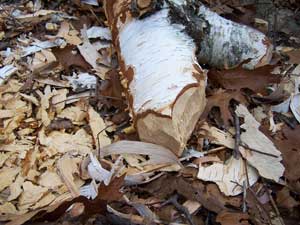Beavers (Castor Canadensis) can be a pest when they flood roads and property. However, they are amazing creatures. Other than humans, they are the only animals that purposefully reshape the local ecosystem to accommodate their needs. By constructing marshes and opening up the forest canopy, they also create diverse habitat for other wildlife like turtles, salamanders, ducks and otters.
Physiologically, beavers are well adapted to the water world. They have webbed hind feet, extra eyelids that serve as water goggles, and flaps to seal all orifices, including lips behind their teeth that enable them to chew underwater. They can remain submerged up to 15 minutes.
 |
Beavers are partial to Birch.
One beaver can fell 200 trees in a year. |
Despite depictions in cartoons, beavers do not use their tails to slap mud onto dams. They carry or shovel mud and stones with their front feet, and haul timber with their teeth. They do use their tails to prop themselves up when gnawing, as a rudder while swimming, and to sound an alarm by slapping the water’s surface.
Scientists believe beavers rely on sound to know when their dam is completed or needs repair. In one study, when scientists played loud tapes of water running, the beavers packed the tape player with mud. If water in a dammed area is clear, the lodge is probably not active, as beavers tend to stir up the bottom.
In addition to dam construction, beavers manufacture a lodge. Their home has an underwater entrance that keeps predators out, and warm air in. Since kits live with their parents for two years, there are often three generations (perhaps 12 animals) in one lodge. An adult can weigh up to 65 lbs. Beavers do not hibernate; but instead remain active year round, usually at night. They stockpile food, weighting branches down with large logs so it will be accessible under the ice during the winter months.
Beavers eat the bark, leaves, twigs, shoots and roots of deciduous trees. They are particularly fond of birch, willow, ash, aspen and maple. Enzymes in their guts enable them to digest wood. They also “recycle” their fecal material, eating pellets twice to extract nutrients. One of these industrious creatures can cut 200 trees per year. They can fell a tree up to 33 inches in diameter.
By the mid-1800’s, beavers had been completely wiped out in Connecticut by unregulated hunting. One pair was reintroduced in Union in 1914. Now DEP estimates there are about 8,000 statewide. In the 1940s, the Argentine government introduced 50 beavers to Tierra del Fuego with disastrous results. The pelt was of inferior quality (thick and greasy) because the climate was too cold, but the exploding population, which now numbers more than 100,000, is decimating forests.
As development encroaches more and more on wildlife habitat, the likelihood of conflict rises. The CT DEP encourages people to tolerate beavers. There are some options to reduce problems, including putting heavy-gauge wire mesh around tree trunks, exclusion fencing at culverts, and trapping (a license is required.) Relocation is not allowed in CT because it just relocates the problem. Installation of a Water Level Control Device, and dam removal and breaching are regulated, so a permit must be obtained from the local Inland Wetlands agency. For more information on beavers and control options, see the CT DEP’s website at http://dep.state.ct.us/burnatr/wildlife/factshts/beaver.htm or call your state Wildlife Management organization.
MORE INFORMATION |
|

